wheel INFINITI QX80 2021 Warranty Information Booklet
[x] Cancel search | Manufacturer: INFINITI, Model Year: 2021, Model line: QX80, Model: INFINITI QX80 2021Pages: 54, PDF Size: 0.34 MB
Page 38 of 54
![INFINITI QX80 2021 Warranty Information Booklet 35
In order for Goodyear Run-Flat (Extended
Mobility Technology [EMT], RunOnFlat [ROF])
or Dunlop Run-Flat (Dunlop Self- Supporting
Technology [DSST]) tires to obtain the
performance criteria stat INFINITI QX80 2021 Warranty Information Booklet 35
In order for Goodyear Run-Flat (Extended
Mobility Technology [EMT], RunOnFlat [ROF])
or Dunlop Run-Flat (Dunlop Self- Supporting
Technology [DSST]) tires to obtain the
performance criteria stat](/img/42/35010/w960_35010-37.png)
35
In order for Goodyear Run-Flat (Extended
Mobility Technology [EMT], RunOnFlat [ROF])
or Dunlop Run-Flat (Dunlop Self- Supporting
Technology [DSST]) tires to obtain the
performance criteria stated within this Limited
Warranty, Goodyear or Dunlop Run- Flat tires
must use specific parts, such as a low tire
pressure monitoring system authorized by the
Original Equipment vehicle manufacturer.
RUN-FLAT TIRE FEATURE:The Goodyear or Dunlop Run-Flat tire is a high
performance tire with a remarkable feature:
It can operate for limited distances with very
low or even no inflation pressure (refer to your
Vehicle Owner’s Manual for these limitations).
This is an important benefit, especially if
inflation loss occurs at a location where
immediately stopping your vehicle could be
hazardous.
TIRE PRESSURE MONITORING
SYSTEM ALERT
Refer to your vehicle Owner’s Manual for more
information on what to do if the tire pressure
warning system activates.
WARNING
If the tire pressure-monitoring system signals
an alert, follow these safety precautions to
prevent a loss of vehicle control that could
result in serious personal injury or death:
•• Slow your speed. Do not exceed 50 mph
(80 kph).
•• Avoid hard cornering, hard braking and
severe handling maneuvers.
•• Avoid potholes and other road hazards.
Remember that when your tires have lost air
pressure, your vehicle’s handling capability is
reduced, particularly during severe maneuvers.
TO PROLONG TIRE LIFE DURING A
SYSTEM ALERT
The Goodyear or Dunlop Run-Flat tire can be
driven at low or zero air pressure (refer to your
vehicle Owner’s Manual for these limitations).
To help prolong the life of a tire operating
under low-inflation conditions, drive at a speed
as far below 50 mph (80 kph) as possible. Also,
drive the shortest distance possible before
obtaining tire service. Taking these precautions
will increase the chance that your tire will be
repairable.
SERVICE AFTER A SYSTEM ALERT To obtain service after operating under low-
inflation conditions, contact your Goodyear or
Dunlop Run-Flat service facility. Trained service
personnel will inspect your tires to determine
if they are in need of repair or replacement.
To locate the nearest authorized Goodyear or
Dunlop Run-Flat service facility, call 1-800-
GOODYEAR (1-800-466-3932).
WARNING
Because of the unique characteristics of
Run-Flat tires, the wheels on which they
are mounted and your vehicle’s tire pressure
monitoring system, all tire service work other
than routine inflation maintenance and
external inspections must be performed by
service personnel at a Goodyear or Dunlop Run-Flat service facility. Do not attempt to
mount or demount Run-Flat tires yourself;
serious injury or death could result. Only
specially trained persons should mount,
demount and repair Run-Flat tires, and more
than 40 psi (270 kPa) may be required to seat
beads. A safety cage and clip-on extension
air hose must be used if more than 40 psi
(270kPa) is needed to seat beads.
TIRE REPAIR Like any other Goodyear or Dunlop speed-
rated, high performance tire, the Goodyear
or Dunlop Run-Flat tire may be repaired to
correct a puncture in the tread, but PROPER
MATERIALS AND PROCEDURES MUST BE
USED. Contact a Goodyear or Dunlop Run-
Flat service facility for information on proper
repairs. For the location of the nearest facility,
call 1-800-GOODYEAR (1-800-466-3932).
WARNING
Goodyear and Dunlop Run-Flat tires are
designed for use only on certain original
equipment wheels supplied with a properly
operating low tire pressure-monitoring system.
If applied to a vehicle without a properly
operating low tire pressure-monitoring
system, the tires may fail when operated in
an underinflated condition, resulting in loss of
vehicle control and possible serious injury or
death. Application of these tires to a vehicle
not equipped with specified operational low
tire pressure monitoring system constitutes
improper and unsafe use of this product.
GOODYEAR/DUNLOP TIRE LIMITED WARRANTY
4303458_21a_INFINITI_US_WIB_032520.indd 354303458_21a_INFINITI_US_WIB_032520.indd 354/8/2020 10:18:18 AM4/8/2020 10:18:18 AM
Page 39 of 54
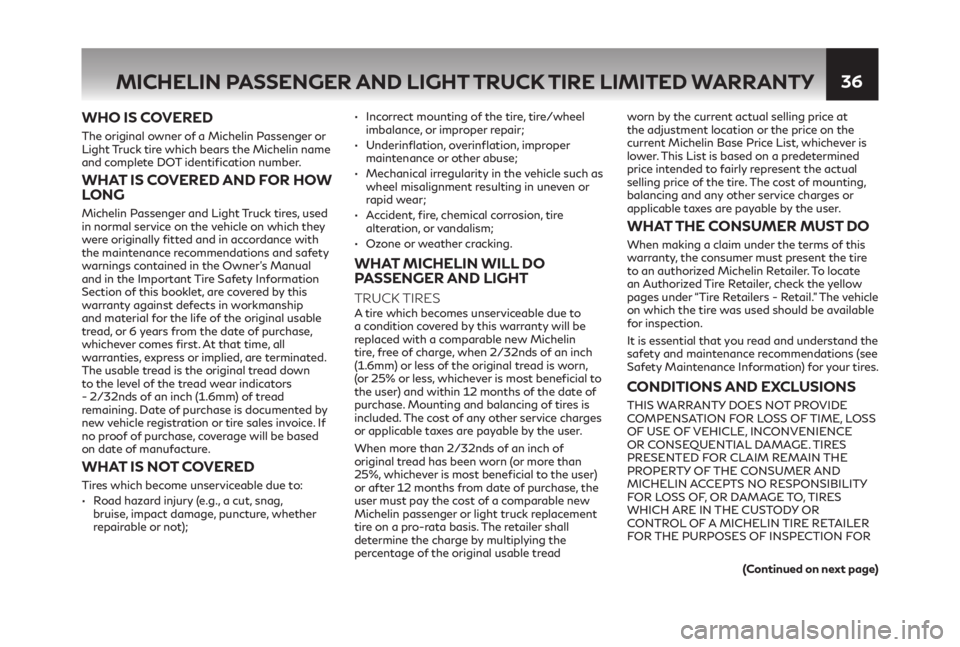
36
WHO IS COVERED
The original owner of a Michelin Passenger or
Light Truck tire which bears the Michelin name
and complete DOT identification number.
WHAT IS COVERED AND FOR HOW
LONG
Michelin Passenger and Light Truck tires, used
in normal service on the vehicle on which they
were originally fitted and in accordance with
the maintenance recommendations and safety
warnings contained in the Owner’s Manual
and in the Important Tire Safety Information
Section of this booklet, are covered by this
warranty against defects in workmanship
and material for the life of the original usable
tread, or 6 years from the date of purchase,
whichever comes first. At that time, all
warranties, express or implied, are terminated.
The usable tread is the original tread down
to the level of the tread wear indicators
- 2/32nds of an inch (1.6mm) of tread
remaining. Date of purchase is documented by
new vehicle registration or tire sales invoice. If
no proof of purchase, coverage will be based
on date of manufacture.
WHAT IS NOT COVERED
Tires which become unserviceable due to:
•• Road hazard injury (e.g., a cut, snag,
bruise, impact damage, puncture, whether
repairable or not);
•• Incorrect mounting of the tire, tire/wheel
imbalance, or improper repair;
•• Underinflation, overinflation, improper
maintenance or other abuse;
•• Mechanical irregularity in the vehicle such as
wheel misalignment resulting in uneven or
rapid wear;
•• Accident, fire, chemical corrosion, tire
alteration, or vandalism;
•• Ozone or weather cracking.
WHAT MICHELIN WILL DO
PASSENGER AND LIGHT
TRUCK TIRES A tire which becomes unserviceable due to
a condition covered by this warranty will be
replaced with a comparable new Michelin
tire, free of charge, when 2/32nds of an inch
(1.6mm) or less of the original tread is worn,
(or 25% or less, whichever is most beneficial to
the user) and within 12 months of the date of
purchase. Mounting and balancing of tires is
included. The cost of any other service charges
or applicable taxes are payable by the user.
When more than 2/32nds of an inch of
original tread has been worn (or more than
25%, whichever is most beneficial to the user)
or after 12 months from date of purchase, the
user must pay the cost of a comparable new
Michelin passenger or light truck replacement
tire on a pro-rata basis. The retailer shall
determine the charge by multiplying the
percentage of the original usable tread worn by the current actual selling price at
the adjustment location or the price on the
current Michelin Base Price List, whichever is
lower. This List is based on a predetermined
price intended to fairly represent the actual
selling price of the tire. The cost of mounting,
balancing and any other service charges or
applicable taxes are payable by the user.
WHAT THE CONSUMER MUST DO
When making a claim under the terms of this
warranty, the consumer must present the tire
to an authorized Michelin Retailer. To locate
an Authorized Tire Retailer, check the yellow
pages under “Tire Retailers - Retail.” The vehicle
on which the tire was used should be available
for inspection.
It is essential that you read and understand the
safety and maintenance recommendations (see
Safety Maintenance Information) for your tires.
CONDITIONS AND EXCLUSIONS
THIS WARRANTY DOES NOT PROVIDE
COMPENSATION FOR LOSS OF TIME, LOSS
OF USE OF VEHICLE, INCONVENIENCE
OR CONSEQUENTIAL DAMAGE. TIRES
PRESENTED FOR CLAIM REMAIN THE
PROPERTY OF THE CONSUMER AND
MICHELIN ACCEPTS NO RESPONSIBILITY
FOR LOSS OF, OR DAMAGE TO, TIRES
WHICH ARE IN THE CUSTODY OR
CONTROL OF A MICHELIN TIRE RETAILER
FOR THE PURPOSES OF INSPECTION FOR
MICHELIN PASSENGER AND LIGHT TRUCK TIRE LIMITED WARRANTY
(Continued on next page)
4303458_21a_INFINITI_US_WIB_032520.indd 364303458_21a_INFINITI_US_WIB_032520.indd 364/8/2020 10:18:18 AM4/8/2020 10:18:18 AM
Page 42 of 54
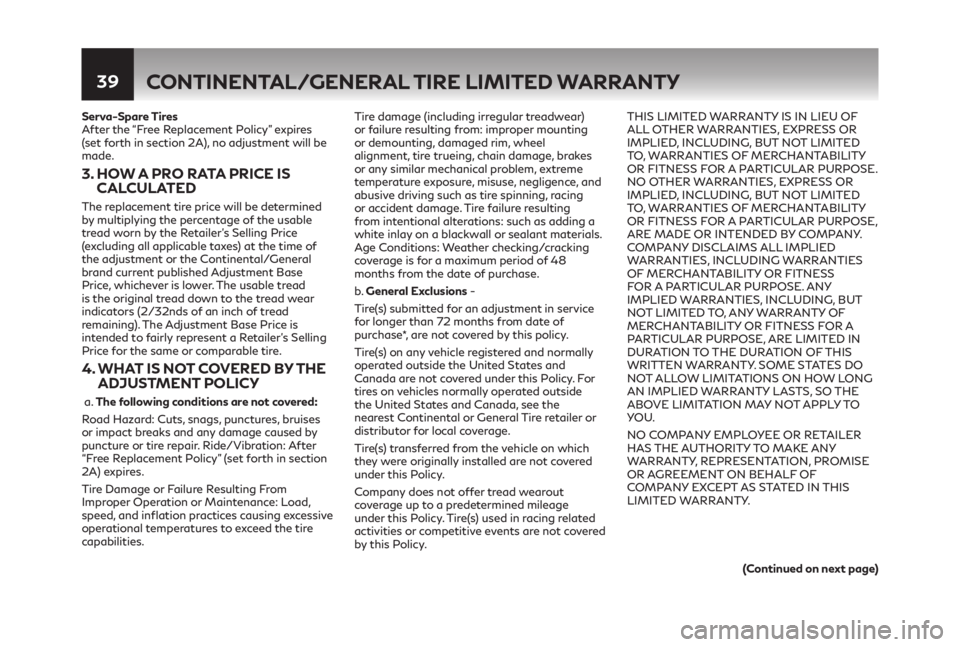
39CONTINENTAL/GENERAL TIRE LIMITED WARRANTY
Serva-Spare Tires
After the “Free Replacement Policy” expires
(set forth in section 2A), no adjustment will be
made.
3. HOW A PRO RATA PRICE IS
CALCULATED
The replacement tire price will be determined
by multiplying the percentage of the usable
tread worn by the Retailer’s Selling Price
(excluding all applicable taxes) at the time of
the adjustment or the Continental/General
brand current published Adjustment Base
Price, whichever is lower. The usable tread
is the original tread down to the tread wear
indicators (2/32nds of an inch of tread
remaining). The Adjustment Base Price is
intended to fairly represent a Retailer’s Selling
Price for the same or comparable tire.
4.
WHAT IS NOT COVERED BY THE
ADJUSTMENT POLICY
a. The following conditions are not covered:
Road Hazard: Cuts, snags, punctures, bruises
or impact breaks and any damage caused by
puncture or tire repair. Ride/Vibration: After
“Free Replacement Policy” (set forth in section
2A) expires.
Tire Damage or Failure Resulting From
Improper Operation or Maintenance: Load,
speed, and inflation practices causing excessive
operational temperatures to exceed the tire
capabilities. Tire damage (including irregular treadwear)
or failure resulting from: improper mounting
or demounting, damaged rim, wheel
alignment, tire trueing, chain damage, brakes
or any similar mechanical problem, extreme
temperature exposure, misuse, negligence, and
abusive driving such as tire spinning, racing
or accident damage. Tire failure resulting
from intentional alterations: such as adding a
white inlay on a blackwall or sealant materials.
Age Conditions: Weather checking/cracking
coverage is for a maximum period of 48
months from the date of purchase.
b . General Exclusions -
Tire(s) submitted for an adjustment in service
for longer than 72 months from date of
purchase*, are not covered by this policy.
Tire(s) on any vehicle registered and normally
operated outside the United States and
Canada are not covered under this Policy. For
tires on vehicles normally operated outside
the United States and Canada, see the
nearest Continental or General Tire retailer or
distributor for local coverage.
Tire(s) transferred from the vehicle on which
they were originally installed are not covered
under this Policy.
Company does not offer tread wearout
coverage up to a predetermined mileage
under this Policy. Tire(s) used in racing related
activities or competitive events are not covered
by this Policy. THIS LIMITED WARRANTY IS IN LIEU OF
ALL OTHER WARRANTIES, EXPRESS OR
IMPLIED, INCLUDING, BUT NOT LIMITED
TO, WARRANTIES OF MERCHANTABILITY
OR FITNESS FOR A PARTICULAR PURPOSE.
NO OTHER WARRANTIES, EXPRESS OR
IMPLIED, INCLUDING, BUT NOT LIMITED
TO, WARRANTIES OF MERCHANTABILITY
OR FITNESS FOR A PARTICULAR PURPOSE,
ARE MADE OR INTENDED BY COMPANY.
COMPANY DISCLAIMS ALL IMPLIED
WARRANTIES, INCLUDING WARRANTIES
OF MERCHANTABILITY OR FITNESS
FOR A PARTICULAR PURPOSE. ANY
IMPLIED WARRANTIES, INCLUDING, BUT
NOT LIMITED TO, ANY WARRANTY OF
MERCHANTABILITY OR FITNESS FOR A
PARTICULAR PURPOSE, ARE LIMITED IN
DURATION TO THE DURATION OF THIS
WRITTEN WARRANTY. SOME STATES DO
NOT ALLOW LIMITATIONS ON HOW LONG
AN IMPLIED WARRANTY LASTS, SO THE
ABOVE LIMITATION MAY NOT APPLY TO
YO U.
NO COMPANY EMPLOYEE OR RETAILER
HAS THE AUTHORITY TO MAKE ANY
WARRANTY, REPRESENTATION, PROMISE
OR AGREEMENT ON BEHALF OF
COMPANY EXCEPT AS STATED IN THIS
LIMITED WARRANTY.
(Continued on next page)
4303458_21a_INFINITI_US_WIB_032520.indd 394303458_21a_INFINITI_US_WIB_032520.indd 394/8/2020 10:18:18 AM4/8/2020 10:18:18 AM
Page 44 of 54
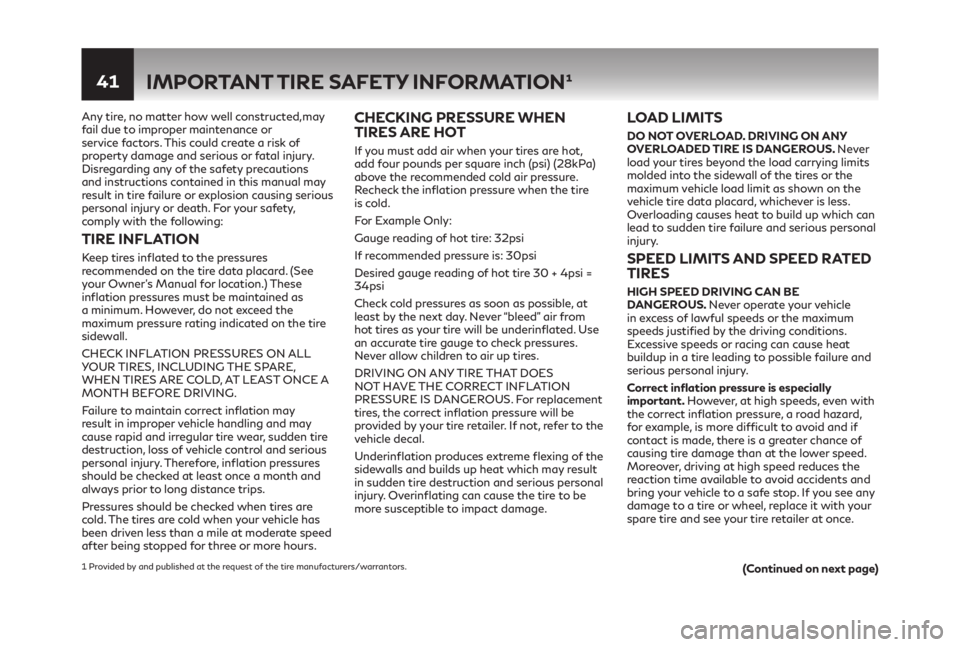
41IMPORTANT TIRE SAFETY INFORMATION¹
Any tire, no matter how well constructed,may
fail due to improper maintenance or
service factors. This could create a risk of
property damage and serious or fatal injury.
Disregarding any of the safety precautions
and instructions contained in this manual may
result in tire failure or explosion causing serious
personal injury or death. For your safety,
comply with the following:
TIRE INFLATION
Keep tires inflated to the pressures
recommended on the tire data placard. (See
your Owner’s Manual for location.) These
inflation pressures must be maintained as
a minimum. However, do not exceed the
maximum pressure rating indicated on the tire
sidewall.
CHECK INFLATION PRESSURES ON ALL
YOUR TIRES, INCLUDING THE SPARE,
WHEN TIRES ARE COLD, AT LEAST ONCE A
MONTH BEFORE DRIVING.
Failure to maintain correct inflation may
result in improper vehicle handling and may
cause rapid and irregular tire wear, sudden tire
destruction, loss of vehicle control and serious
personal injury. Therefore, inflation pressures
should be checked at least once a month and
always prior to long distance trips.
Pressures should be checked when tires are
cold. The tires are cold when your vehicle has
been driven less than a mile at moderate speed
after being stopped for three or more hours.
CHECKING PRESSURE WHEN
TIRES ARE HOT
If you must add air when your tires are hot,
add four pounds per square inch (psi) (28kPa)
above the recommended cold air pressure.
Recheck the inflation pressure when the tire
is cold.
For Example Only:
Gauge reading of hot tire: 32psi
If recommended pressure is: 30psi
Desired gauge reading of hot tire 30 + 4psi =
34psi
Check cold pressures as soon as possible, at
least by the next day. Never “bleed” air from
hot tires as your tire will be underinflated. Use
an accurate tire gauge to check pressures.
Never allow children to air up tires.
DRIVING ON ANY TIRE THAT DOES
NOT HAVE THE CORRECT INFLATION
PRESSURE IS DANGEROUS. For replacement
tires, the correct inflation pressure will be
provided by your tire retailer. If not, refer to the
vehicle decal.
Underinflation produces extreme flexing of the
sidewalls and builds up heat which may result
in sudden tire destruction and serious personal
injury. Overinflating can cause the tire to be
more susceptible to impact damage.
LOAD LIMITS
DO NOT OVERLOAD. DRIVING ON ANY
OVERLOADED TIRE IS DANGEROUS. Never
load your tires beyond the load carrying limits
molded into the sidewall of the tires or the
maximum vehicle load limit as shown on the
vehicle tire data placard, whichever is less.
Overloading causes heat to build up which can
lead to sudden tire failure and serious personal
injury.
SPEED LIMITS AND SPEED RATED
TIRES
HIGH SPEED DRIVING CAN BE
DANGEROUS. Never operate your vehicle
in excess of lawful speeds or the maximum
speeds justified by the driving conditions.
Excessive speeds or racing can cause heat
buildup in a tire leading to possible failure and
serious personal injury.
Correct inflation pressure is especially
important. However, at high speeds, even with
the correct inflation pressure, a road hazard,
for example, is more difficult to avoid and if
contact is made, there is a greater chance of
causing tire damage than at the lower speed.
Moreover, driving at high speed reduces the
reaction time available to avoid accidents and
bring your vehicle to a safe stop. If you see any
damage to a tire or wheel, replace it with your
spare tire and see your tire retailer at once.
(Continued on next page)
1 Provided by and published at the request of the tire manufacturers/warrantors.
4303458_21a_INFINITI_US_WIB_032520.indd 414303458_21a_INFINITI_US_WIB_032520.indd 414/8/2020 10:18:18 AM4/8/2020 10:18:18 AM
Page 46 of 54
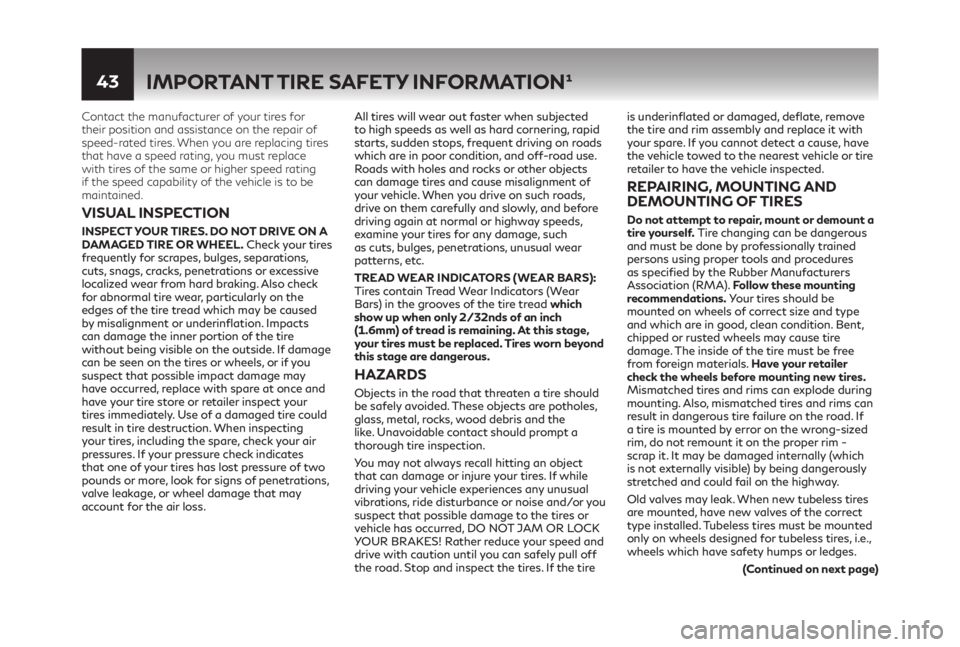
43
Contact the manufacturer of your tires for
their position and assistance on the repair of
speed-rated tires. When you are replacing tires
that have a speed rating, you must replace
with tires of the same or higher speed rating
if the speed capability of the vehicle is to be
maintained.
VISUAL INSPECTION
INSPECT YOUR TIRES. DO NOT DRIVE ON A
DAMAGED TIRE OR WHEEL. Check your tires
frequently for scrapes, bulges, separations,
cuts, snags, cracks, penetrations or excessive
localized wear from hard braking. Also check
for abnormal tire wear, particularly on the
edges of the tire tread which may be caused
by misalignment or underinflation. Impacts
can damage the inner portion of the tire
without being visible on the outside. If damage
can be seen on the tires or wheels, or if you
suspect that possible impact damage may
have occurred, replace with spare at once and
have your tire store or retailer inspect your
tires immediately. Use of a damaged tire could
result in tire destruction. When inspecting
your tires, including the spare, check your air
pressures. If your pressure check indicates
that one of your tires has lost pressure of two
pounds or more, look for signs of penetrations,
valve leakage, or wheel damage that may
account for the air loss. All tires will wear out faster when subjected
to high speeds as well as hard cornering, rapid
starts, sudden stops, frequent driving on roads
which are in poor condition, and off-road use.
Roads with holes and rocks or other objects
can damage tires and cause misalignment of
your vehicle. When you drive on such roads,
drive on them carefully and slowly, and before
driving again at normal or highway speeds,
examine your tires for any damage, such
as cuts, bulges, penetrations, unusual wear
patterns, etc.
TREAD WEAR INDICATORS (WEAR BARS):
Tires contain Tread Wear Indicators (Wear
Bars) in the grooves of the tire tread which
show up when only 2/32nds of an inch
(1.6mm) of tread is remaining. At this stage,
your tires must be replaced. Tires worn beyond
this stage are dangerous.
HAZARDS
Objects in the road that threaten a tire should
be safely avoided. These objects are potholes,
glass, metal, rocks, wood debris and the
like. Unavoidable contact should prompt a
thorough tire inspection.
You may not always recall hitting an object
that can damage or injure your tires. If while
driving your vehicle experiences any unusual
vibrations, ride disturbance or noise and/or you
suspect that possible damage to the tires or
vehicle has occurred, DO NOT JAM OR LOCK
YOUR BRAKES! Rather reduce your speed and
drive with caution until you can safely pull off
the road. Stop and inspect the tires. If the tire is underinflated or damaged, deflate, remove
the tire and rim assembly and replace it with
your spare. If you cannot detect a cause, have
the vehicle towed to the nearest vehicle or tire
retailer to have the vehicle inspected.
REPAIRING, MOUNTING AND
DEMOUNTING OF TIRES
Do not attempt to repair, mount or demount a
tire yourself. Tire changing can be dangerous
and must be done by professionally trained
persons using proper tools and procedures
as specified by the Rubber Manufacturers
Association (RMA). Follow these mounting
recommendations. Your tires should be
mounted on wheels of correct size and type
and which are in good, clean condition. Bent,
chipped or rusted wheels may cause tire
damage. The inside of the tire must be free
from foreign materials. Have your retailer
check the wheels before mounting new tires.
Mismatched tires and rims can explode during
mounting. Also, mismatched tires and rims can
result in dangerous tire failure on the road. If
a tire is mounted by error on the wrong-sized
rim, do not remount it on the proper rim -
scrap it. It may be damaged internally (which
is not externally visible) by being dangerously
stretched and could fail on the highway.
Old valves may leak. When new tubeless tires
are mounted, have new valves of the correct
type installed. Tubeless tires must be mounted
only on wheels designed for tubeless tires, i.e.,
wheels which have safety humps or ledges.
IMPORTANT TIRE SAFETY INFORMATION¹
(Continued on next page)
4303458_21a_INFINITI_US_WIB_032520.indd 434303458_21a_INFINITI_US_WIB_032520.indd 434/8/2020 10:18:18 AM4/8/2020 10:18:18 AM
Page 47 of 54
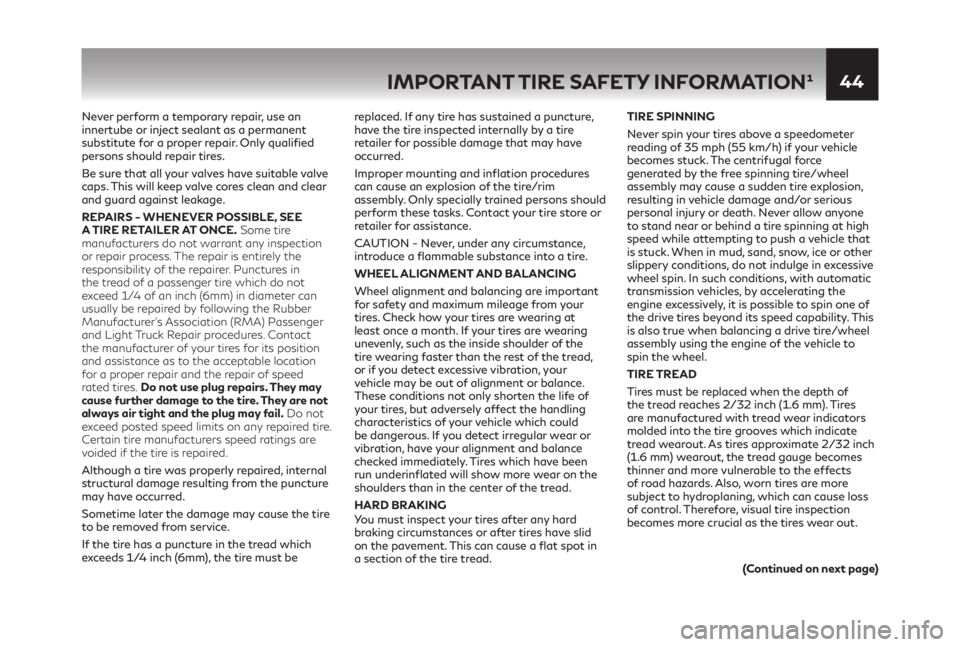
44
Never perform a temporary repair, use an
innertube or inject sealant as a permanent
substitute for a proper repair. Only qualified
persons should repair tires.
Be sure that all your valves have suitable valve
caps. This will keep valve cores clean and clear
and guard against leakage.
REPAIRS - WHENEVER POSSIBLE, SEE
A TIRE RETAILER AT ONCE. Some tire
manufacturers do not warrant any inspection
or repair process. The repair is entirely the
responsibility of the repairer. Punctures in
the tread of a passenger tire which do not
exceed 1/4 of an inch (6mm) in diameter can
usually be repaired by following the Rubber
Manufacturer’s Association (RMA) Passenger
and Light Truck Repair procedures. Contact
the manufacturer of your tires for its position
and assistance as to the acceptable location
for a proper repair and the repair of speed
rated tires. Do not use plug repairs. They may
cause further damage to the tire. They are not
always air tight and the plug may fail. Do not
exceed posted speed limits on any repaired tire.
Certain tire manufacturers speed ratings are
voided if the tire is repaired.
Although a tire was properly repaired, internal
structural damage resulting from the puncture
may have occurred.
Sometime later the damage may cause the tire
to be removed from service.
If the tire has a puncture in the tread which
exceeds 1/4 inch (6mm), the tire must be replaced. If any tire has sustained a puncture,
have the tire inspected internally by a tire
retailer for possible damage that may have
occurred.
Improper mounting and inflation procedures
can cause an explosion of the tire/rim
assembly. Only specially trained persons should
perform these tasks. Contact your tire store or
retailer for assistance.
CAUTION - Never, under any circumstance,
introduce a flammable substance into a tire.
WHEEL ALIGNMENT AND BALANCING
Wheel alignment and balancing are important
for safety and maximum mileage from your
tires. Check how your tires are wearing at
least once a month. If your tires are wearing
unevenly, such as the inside shoulder of the
tire wearing faster than the rest of the tread,
or if you detect excessive vibration, your
vehicle may be out of alignment or balance.
These conditions not only shorten the life of
your tires, but adversely affect the handling
characteristics of your vehicle which could
be dangerous. If you detect irregular wear or
vibration, have your alignment and balance
checked immediately. Tires which have been
run underinflated will show more wear on the
shoulders than in the center of the tread.
HARD BRAKING
You must inspect your tires after any hard
braking circumstances or after tires have slid
on the pavement. This can cause a flat spot in
a section of the tire tread. TIRE SPINNING
Never spin your tires above a speedometer
reading of 35 mph (55 km/h) if your vehicle
becomes stuck. The centrifugal force
generated by the free spinning tire/wheel
assembly may cause a sudden tire explosion,
resulting in vehicle damage and/or serious
personal injury or death. Never allow anyone
to stand near or behind a tire spinning at high
speed while attempting to push a vehicle that
is stuck. When in mud, sand, snow, ice or other
slippery conditions, do not indulge in excessive
wheel spin. In such conditions, with automatic
transmission vehicles, by accelerating the
engine excessively, it is possible to spin one of
the drive tires beyond its speed capability. This
is also true when balancing a drive tire/wheel
assembly using the engine of the vehicle to
spin the wheel.
TIRE TREAD
Tires must be replaced when the depth of
the tread reaches 2/32 inch (1.6 mm). Tires
are manufactured with tread wear indicators
molded into the tire grooves which indicate
tread wearout. As tires approximate 2/32 inch
(1.6 mm) wearout, the tread gauge becomes
thinner and more vulnerable to the effects
of road hazards. Also, worn tires are more
subject to hydroplaning, which can cause loss
of control. Therefore, visual tire inspection
becomes more crucial as the tires wear out.
(Continued on next page)
IMPORTANT TIRE SAFETY INFORMATION¹
4303458_21a_INFINITI_US_WIB_032520.indd 444303458_21a_INFINITI_US_WIB_032520.indd 444/8/2020 10:18:19 AM4/8/2020 10:18:19 AM
Page 48 of 54
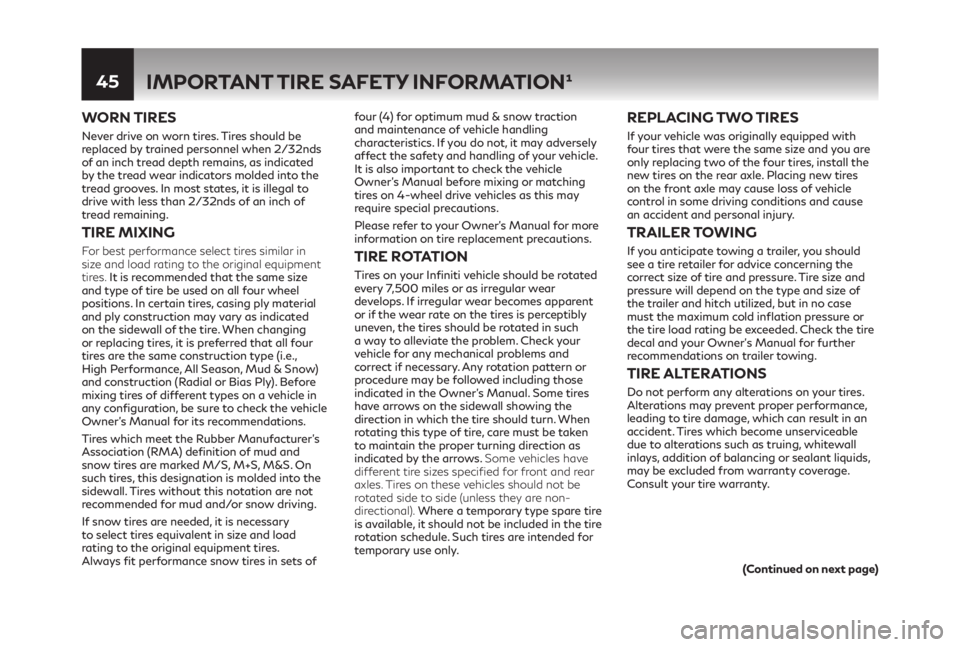
45
WORN TIRES
Never drive on worn tires. Tires should be
replaced by trained personnel when 2/32nds
of an inch tread depth remains, as indicated
by the tread wear indicators molded into the
tread grooves. In most states, it is illegal to
drive with less than 2/32nds of an inch of
tread remaining.
TIRE MIXING
For best performance select tires similar in
size and load rating to the original equipment
tires. It is recommended that the same size
and type of tire be used on all four wheel
positions. In certain tires, casing ply material
and ply construction may vary as indicated
on the sidewall of the tire. When changing
or replacing tires, it is preferred that all four
tires are the same construction type (i.e.,
High Performance, All Season, Mud & Snow)
and construction (Radial or Bias Ply). Before
mixing tires of different types on a vehicle in
any configuration, be sure to check the vehicle
Owner’s Manual for its recommendations.
Tires which meet the Rubber Manufacturer’s
Association (RMA) definition of mud and
snow tires are marked M/S, M+S, M&S. On
such tires, this designation is molded into the
sidewall. Tires without this notation are not
recommended for mud and/or snow driving.
If snow tires are needed, it is necessary
to select tires equivalent in size and load
rating to the original equipment tires.
Always fit performance snow tires in sets of four (4) for optimum mud & snow traction
and maintenance of vehicle handling
characteristics. If you do not, it may adversely
affect the safety and handling of your vehicle.
It is also important to check the vehicle
Owner’s Manual before mixing or matching
tires on 4-wheel drive vehicles as this may
require special precautions.
Please refer to your Owner’s Manual for more
information on tire replacement precautions. TIRE ROTATION
Tires on your Infiniti vehicle should be rotated
every 7,500 miles or as irregular wear
develops. If irregular wear becomes apparent
or if the wear rate on the tires is perceptibly
uneven, the tires should be rotated in such
a way to alleviate the problem. Check your
vehicle for any mechanical problems and
correct if necessary. Any rotation pattern or
procedure may be followed including those
indicated in the Owner’s Manual. Some tires
have arrows on the sidewall showing the
direction in which the tire should turn. When
rotating this type of tire, care must be taken
to maintain the proper turning direction as
indicated by the arrows. Some vehicles have
different tire sizes specified for front and rear
axles. Tires on these vehicles should not be
rotated side to side (unless they are non-
directional). Where a temporary type spare tire
is available, it should not be included in the tire
rotation schedule. Such tires are intended for
temporary use only.
REPLACING TWO TIRES
If your vehicle was originally equipped with
four tires that were the same size and you are
only replacing two of the four tires, install the
new tires on the rear axle. Placing new tires
on the front axle may cause loss of vehicle
control in some driving conditions and cause
an accident and personal injury.
TRAILER TOWING
If you anticipate towing a trailer, you should
see a tire retailer for advice concerning the
correct size of tire and pressure. Tire size and
pressure will depend on the type and size of
the trailer and hitch utilized, but in no case
must the maximum cold inflation pressure or
the tire load rating be exceeded. Check the tire
decal and your Owner’s Manual for further
recommendations on trailer towing.
TIRE ALTERATIONS
Do not perform any alterations on your tires.
Alterations may prevent proper performance,
leading to tire damage, which can result in an
accident. Tires which become unserviceable
due to alterations such as truing, whitewall
inlays, addition of balancing or sealant liquids,
may be excluded from warranty coverage.
Consult your tire warranty.
(Continued on next page)
IMPORTANT TIRE SAFETY INFORMATION¹
4303458_21a_INFINITI_US_WIB_032520.indd 454303458_21a_INFINITI_US_WIB_032520.indd 454/8/2020 10:18:19 AM4/8/2020 10:18:19 AM
Page 49 of 54
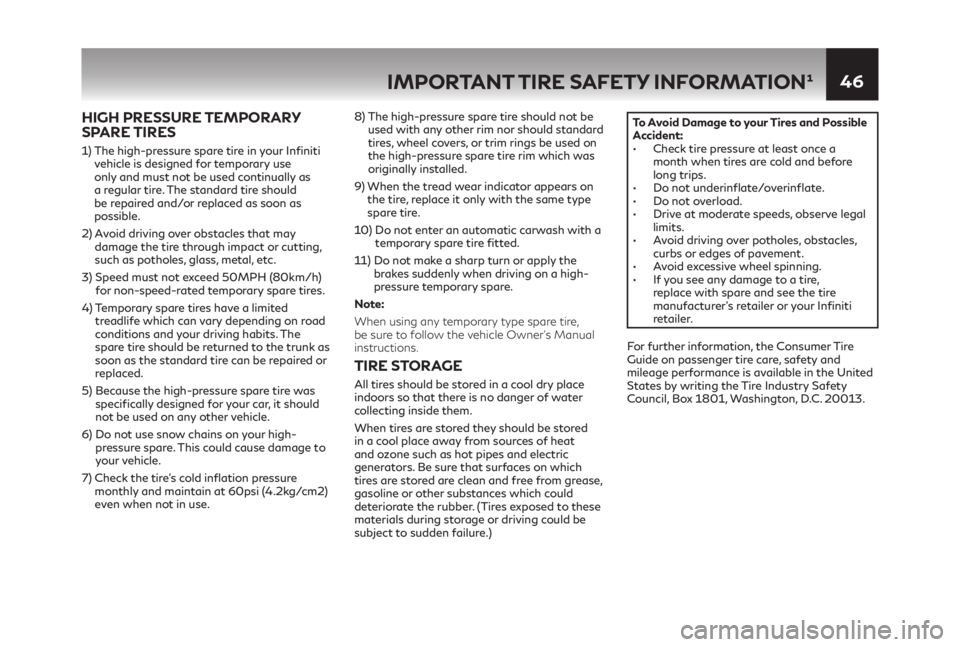
46
HIGH PRESSURE TEMPORARY
SPARE TIRES
1)
The high-pressure spare tire in your Infiniti
vehicle is designed for temporary use
only and must not be used continually as
a regular tire. The standard tire should
be repaired and/or replaced as soon as
possible.
2)
Avoid driving over obstacles that may
damage the tire through impact or cutting,
such as potholes, glass, metal, etc.
3) Speed must not exceed 50MPH (80km/h)
for non-speed-rated temporary spare tires.
4)
Temporary spare tires have a limited
treadlife which can vary depending on road
conditions and your driving habits. The
spare tire should be returned to the trunk as
soon as the standard tire can be repaired or
replaced.
5) Because the high-pressure spare tire was
specifically designed for your car, it should
not be used on any other vehicle.
6) Do not use snow chains on your high-
pressure spare. This could cause damage to
your vehicle.
7) Check the tire’s cold inflation pressure
monthly and maintain at 60psi (4.2kg/cm2)
even when not in use. 8)
The high-pressure spare tire should not be
used with any other rim nor should standard
tires, wheel covers, or trim rings be used on
the high-pressure spare tire rim which was
originally installed.
9)
When the tread wear indicator appears on
the tire, replace it only with the same type
spare tire.
10) Do not enter an automatic carwash with a
temporary spare tire fitted.
11) Do not make a sharp turn or apply the
brakes suddenly when driving on a high-
pressure temporary spare.
Note:
When using any temporary type spare tire,
be sure to follow the vehicle Owner’s Manual
instructions.
TIRE STORAGE
All tires should be stored in a cool dry place
indoors so that there is no danger of water
collecting inside them.
When tires are stored they should be stored
in a cool place away from sources of heat
and ozone such as hot pipes and electric
generators. Be sure that surfaces on which
tires are stored are clean and free from grease,
gasoline or other substances which could
deteriorate the rubber. (Tires exposed to these
materials during storage or driving could be
subject to sudden failure.) To Avoid Damage to your Tires and Possible
Accident:
•• Check tire pressure at least once a
month when tires are cold and before
long trips.
•• Do not underinflate/overinflate.•• Do not overload.•• Drive at moderate speeds, observe legal
limits.
•• Avoid driving over potholes, obstacles,
curbs or edges of pavement.
•• Avoid excessive wheel spinning.•• If you see any damage to a tire,
replace with spare and see the tire
manufacturer’s retailer or your Infiniti
retailer.
For further information, the Consumer Tire
Guide on passenger tire care, safety and
mileage performance is available in the United
States by writing the Tire Industry Safety
Council, Box 1801, Washington, D.C. 20013.
IMPORTANT TIRE SAFETY INFORMATION¹
4303458_21a_INFINITI_US_WIB_032520.indd 464303458_21a_INFINITI_US_WIB_032520.indd 464/8/2020 10:18:19 AM4/8/2020 10:18:19 AM
Page 52 of 54
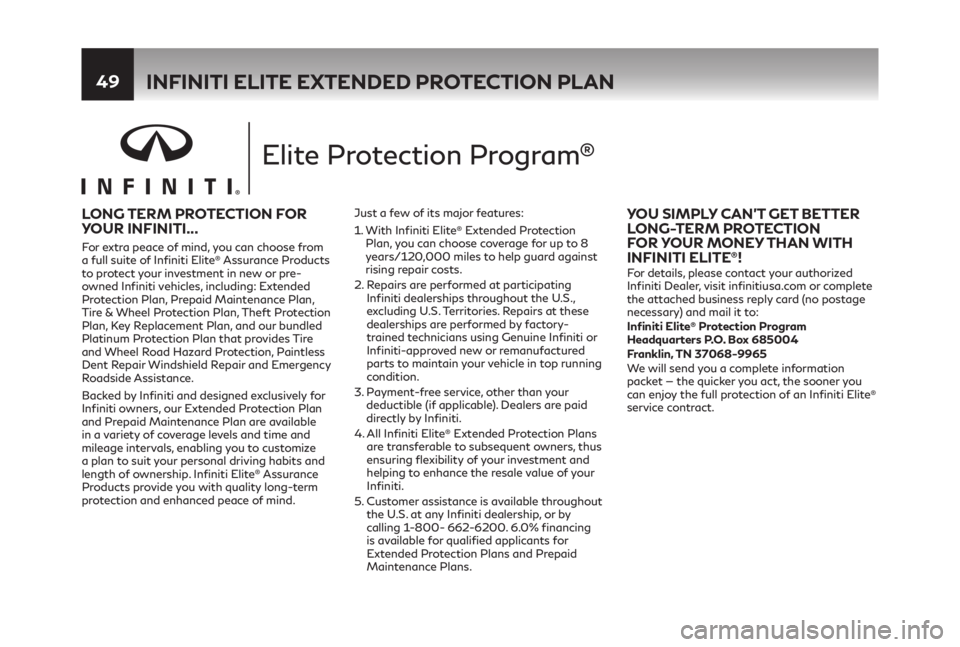
49
LONG TERM PROTECTION FOR
YOUR INFINITI...
For extra peace of mind, you can choose from
a full suite of Infiniti Elite® Assurance Products
to protect your investment in new or pre-
owned Infiniti vehicles, including: Extended
Protection Plan, Prepaid Maintenance Plan,
Tire & Wheel Protection Plan, Theft Protection
Plan, Key Replacement Plan, and our bundled
Platinum Protection Plan that provides Tire
and Wheel Road Hazard Protection, Paintless
Dent Repair Windshield Repair and Emergency
Roadside Assistance.
Backed by Infiniti and designed exclusively for
Infiniti owners, our Extended Protection Plan
and Prepaid Maintenance Plan are available
in a variety of coverage levels and time and
mileage intervals, enabling you to customize
a plan to suit your personal driving habits and
length of ownership. Infiniti Elite
® Assurance
Products provide you with quality long-term
protection and enhanced peace of mind. Just a few of its major features:
1.
With Infiniti Elite
® Extended Protection
Plan, you can choose coverage for up to 8
years/120,000 miles to help guard against
rising repair costs.
2. Repairs are performed at participating
Infiniti dealerships throughout the U.S.,
excluding U.S. Territories. Repairs at these
dealerships are performed by factory-
trained technicians using Genuine Infiniti or
Infiniti-approved new or remanufactured
parts to maintain your vehicle in top running
condition.
3. Payment-free service, other than your
deductible (if applicable). Dealers are paid
directly by Infiniti.
4.
All Infiniti Elite
® Extended Protection Plans
are transferable to subsequent owners, thus
ensuring flexibility of your investment and
helping to enhance the resale value of your
Infiniti.
5. Customer assistance is available throughout
the U.S. at any Infiniti dealership, or by
calling 1-800- 662-6200. 6.0% financing
is available for qualified applicants for
Extended Protection Plans and Prepaid
Maintenance Plans.
YOU SIMPLY CAN’T GET BETTER
LONG-TERM PROTECTION
FOR YOUR MONEY THAN WITH
INFINITI ELITE
®! For details, please contact your authorized
Infiniti Dealer, visit infinitiusa.com or complete
the attached business reply card (no postage
necessary) and mail it to:
Infiniti Elite
® Protection Program
Headquarters P.O. Box 685004
Franklin, TN 37068-9965
We will send you a complete information
packet — the quicker you act, the sooner you
can enjoy the full protection of an Infiniti Elite
®
service contract.
INFINITI ELITE EXTENDED PROTECTION PLAN
Elite Pr otection Pr ogram
®
Elite Pr otection Pr ogram®
4303458_21a_INFINITI_US_WIB_032520.indd 494303458_21a_INFINITI_US_WIB_032520.indd 494/8/2020 10:18:33 AM4/8/2020 10:18:33 AM